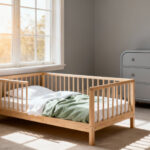Alright, let’s talk about a space that can make or break your vibe as a host. No, it’s not your media room (we’ll get to that). It’s not your bar setup. It’s your bathroom cabinet.
Stay with me here. You’ve spent weeks, maybe months, perfecting your entertainment space. The screen is calibrated, the speakers are balanced, the seating is an open invitation to hang out. Your friends come over, the game is on, the music is perfect. Then, someone quietly asks for a band-aid. Or an aspirin. And you direct them to a guest bathroom where the cabinet is an absolute war zone of half-empty bottles, mystery tubes, and three-year-old sunscreen.
Suddenly, the illusion of the effortless, cool host shatters. A well-organized home is a holistic experience, and that experience includes the spaces your guests actually use. Your morning routine is the same—a frantic search for what you need kills your energy before the day even begins. Getting your bathroom storage sorted isn’t just about being neat; it’s about reclaiming your time and making your entire home feel welcoming and functional.
So, let’s apply some of the same systems-thinking we use for a high-end media setup to this small, chaotic space. It’s time to transform that cabinet from a black hole of stress into a beacon of calm efficiency.
1. The Total System Reboot: Empty Everything
First things first: you have to see what you’re working with. And I mean all of it. Pull every last thing out of that cabinet. Yes, everything. Pile it up on a towel on the floor or the counter. It’s going to look terrifying for a minute, I promise. You’ll probably uncover products you forgot you even bought.

I had a client once who was convinced they were out of toothpaste. After we did the Great Emptying, we found four brand-new tubes hiding behind a graveyard of expired face masks. Seeing the full inventory laid bare is the only way to get a true diagnostic of the situation. It’s like unplugging a complex AV system before you start troubleshooting. You need a clean slate before you can build something better.
This is the point where you get to see the full scope of the problem. Don’t get discouraged—this is where the fun starts.
2. The Great Purge: Be Unsentimental
Now, stare at that pile of stuff you just excavated. It’s time to get ruthless. We’re not creating a museum of past skincare trends; we’re building a functional system for your life now. If you haven’t used that fancy-but-weird-smelling face cream in the last six months, you’re not going to. Toss it. That half-used bottle of shampoo you didn’t love? It’s taking up prime real estate. Let it go.

Expiration dates are non-negotiable. Medications, sunscreens, and active skincare ingredients lose their potency and can even become harmful. Think of expired products like outdated software—they don’t run well and they’re a security risk. A shocking amount of cabinet space is often occupied by things that are literally useless or unsafe.
This step feels so good. It’s liberating. You’re not just clearing physical space; you’re clearing mental clutter. The goal isn’t to have the most products, it’s to have the right products.
3. The Deep Clean: Prepping the Hardware
Before a single thing goes back in, give the cabinet itself a deep, satisfying clean. Bathrooms are humid, dusty environments. You’ll find a surprising amount of gunk—spilled powders, sticky lotion drips, and layers of dust. This isn’t just about looking nice; it’s about creating a healthy, stable environment for the things you put on your body.

Use a good multi-surface cleaner, get into the corners, and wipe everything down until it’s spotless. This is your foundation. I always tell my clients you wouldn’t install a brand-new 8K TV on a dusty, wobbly stand, right? The same logic applies here. Give your awesome new system a clean platform to live on.
Let everything air dry completely. Trapping moisture in a closed cabinet is a recipe for mildew, and nobody wants that. This step is a non-negotiable for me.
4. Logic Groups: Your Personal User Interface
Okay, with your clean, empty cabinet and your pile of “keep” items, it’s time to think like a UX designer. The goal is to make your cabinet so intuitive you could find things in the dark. Start grouping similar items into logical categories. Don’t just follow a generic list—create categories that make sense for your routine.

Maybe you have a “Morning Routine” bucket with face wash, moisturizer, and daily contacts. An “Evening” bucket. A “Hair Stuff” zone. Then you’ll have “Dental,” “First-Aid,” and “Once-in-a-While.” As you create these groups, you’ll see exactly what you have. “Wow, I have six different kinds of face masks and no band-aids.” This is data! You can use it to stop buying duplicates and fill in the gaps.
This process transforms the chaos into a series of clear, findable files. You’re building the main menu for your bathroom.
5. Measure Twice, Buy Once
Before you rush out and buy a bunch of cute acrylic bins, stop. Grab a measuring tape. Measure the interior width, depth, and height of your cabinet space. Make a note of any annoying pipes under the sink or the lip of the cabinet frame.

So many people skip this step, get excited at The Container Store, and come home with a bunch of expensive plastic that doesn’t actually fit. It’s the home-organizing equivalent of buying a giant sofa that won’t fit through the door. A quick sketch with dimensions will be your best friend when you’re shopping for organizers.
Accurate measurements are what let you use every single inch of space effectively. This is how you go from amateur to pro.
6. Go Vertical: Claim the Airspace
Look at your shelves. See all that empty air above your stuff? That’s wasted space. It’s like having a giant TV stand with only one small box on it. Stackable solutions are the answer. They let you take advantage of the full vertical real estate of your cabinet.

Clear, stackable drawers are one of my favorite tools. They let you stack while still being able to access the items at the bottom without unstacking everything. For things you use less often, simple stackable bins work just fine. You’re essentially doubling or even tripling your storage footprint without any construction.
Just make sure whatever you get is sturdy. A wobbly tower of stuff is just a new kind of clutter waiting to happen.
7. Contain the Chaos Agents
Every bathroom has them. Bobby pins, hair ties, cotton swabs, floss picks, tweezers… the tiny little items that seem to breed and spread like chaos itself. If you just toss them in a drawer, they’ll be lost forever. These items need their own, specific homes.

Shallow trays and small, divided organizers are perfect for this. The key is containment. By giving these tiny troublemakers a designated spot, you stop them from getting all over the place. Think of it like cable management for your toiletries; a little effort to contain things makes the whole system look and work infinitely better.
And honestly, there’s nothing more satisfying than sliding open a drawer where every little thing has its perfect, tiny home. It’s a small moment of Zen in your day.
8. The Power of Transparency: See What You’ve Got
When you’re choosing bins and containers, go with clear ones whenever possible. Seriously. Opaque, colorful boxes look cute on Instagram, but in real life, they just become mystery boxes. You forget what’s in them, and you’re back to pulling everything out just to find one thing.

Clear acrylic or plastic turns your cabinet into a visual inventory. You can see what you have at a glance, which saves you time every single morning and stops you from buying that fifth bottle of body lotion you don’t need. It creates this sense of calm and control because there are no secrets. Your brain doesn’t have to work as hard.
What you see is what you have. It’s simple, efficient, and it just works.
9. Labels: Programming the System
If you live with anyone else, or if you just want your future self to thank you, labels are your secret weapon. Labels are what turn a personal organization project into a sustainable, multi-user system. They are the user interface text that tells everyone (including you, on a tired morning) where things go.

You don’t need a fancy label maker, though they are fun. Simple, waterproof stickers work just fine. By clearly labeling each bin—“Daily Skincare,” “First-Aid,” “Hair Ties & Clips”—you eliminate guesswork. It makes putting things away just as easy as taking them out.
This is the step that makes the whole system stick. It automates the process of staying organized, so you’re not doing this whole project over again in six months.
10. Prime Real Estate for Daily Use
In any system, some things are more important than others. In your bathroom cabinet, the items you use every single day deserve the absolute best spot. That means eye-level, front-and-center, easiest-to-reach. Your toothbrush, your face wash, your contact lens case—whatever you grab without thinking every morning.

Putting these things in the “prime real estate” zone makes your daily routine smoother. You’re not bending down or reaching up high for the stuff you need twice a day. This is one of the biggest “quality of life” improvements you can make. The stuff you only use once a week or once a month can go on the higher shelves or in the back.
Think about the flow of your routine. What do you grab first? Second? Third? Arrange them in that prime zone to create a seamless, ergonomic workflow.
11. Deep Storage for the Backups
We all like to buy in bulk to save a little money—the giant pack of toilet paper, the three-pack of deodorant. But those backup items shouldn’t be cluttering up your prime real estate. They belong in the “archives”—the less accessible spots.

The top shelf that you need a step stool for? Perfect for extra soap. The very back of the deep cabinet under the sink? Ideal for that bulk buy of shampoo. You’re creating a smart inventory system: when you use up the product in your “daily use” zone, you “shop” from your archives to replace it, and then add that item to your actual shopping list.
This tiered approach keeps your daily-use areas clean and functional while still giving you space for a well-stocked home.
12. Hardware Upgrades: The Magic of Pull-Outs
The deep, dark cabinet under the sink is the bane of many bathrooms, especially with that awkward pipe in the middle. It’s where products go to die. The solution? A hardware upgrade. Installing pull-out drawers or sliding shelves completely transforms these spaces.

Instead of getting on your hands and knees and blindly reaching into the abyss, you just give a gentle pull, and the entire contents of the cabinet glide out to meet you. It’s a total game-changer for accessibility. There are tons of options out there, including two-tiered versions designed specifically to fit around plumbing.
This is one of those investments that pays you back in reduced frustration every single day. It’s pure mechanical satisfaction.
13. Use the Doors! Don’t Waste an Inch.
The inside of your cabinet doors is some of the most under-utilized real estate in the entire bathroom. It’s the perfect spot for slim storage. Small, stick-on acrylic shelves or magnetic organizers can give you a whole new storage surface for things like makeup brushes, tubes of ointment, toothbrushes, or combs.

This is my favorite trick for getting small, frequently-used items out of the main cabinet space and into a place where they’re immediately visible and grab-able. Just make sure whatever you mount on the door won’t crash into your shelf contents when you close it.
It’s a simple move that dramatically increases your storage capacity. It’s found space you never knew you had.
14. Magnetic Strips for the Metal Bits
Here’s another little “hardware” trick I love. Small metal tools—tweezers, nail clippers, those little cosmetic scissors—are masters of disguise. They vanish into drawers. A simple magnetic strip, like one for kitchen knives, mounted to the inside of a cabinet door or wall, is the perfect fix.

Your tools just click right into place. They stay visible, secure, and easy to grab. No more digging. Plus, it keeps sharp items from rattling around loose in a drawer, which is a nice little safety bonus. It’s an elegant, slightly techy solution that looks clean and works perfectly.
For a few bucks, you can solve one of the most annoying little organizational problems for good.
15. The Safety Zone: Separate Cleaning Supplies
This one is less of a “cool trick” and more of a “seriously, don’t mess this up” rule. Your bathroom cleaning supplies—bleach, tile cleaner, toilet bowl scrub—should never be stored next to your personal care products. Never.

Chemicals need their own, dedicated zone, preferably in a separate bin and away from anything that goes on your skin or in your mouth. This prevents cross-contamination, accidental spills ruining your expensive moisturizer, or worse. If you have kids in the house, this section of the cabinet absolutely needs a child-safety lock.
This isn’t about aesthetics; it’s about common sense and safety. Create a clear, unmistakable boundary that everyone in the house understands.
16. A Clear System for Medications
Medication needs to be handled with care. If you’re keeping it in the bathroom (which, by the way, isn’t ideal for some meds due to heat and humidity—check your labels!), it needs its own strict system. Start by separating prescriptions by the person they belong to. Then, group over-the-counter stuff by type: Pain & Fever, Cold & Flu, Stomach, etc.

Using a small, divided container or a dedicated shelf helps prevent dangerous mix-ups, especially in the middle of the night when you’re fumbling for the Tylenol. And please, for the love of all that is good, go through them and dispose of anything expired. Most pharmacies have take-back programs for safe disposal.
When it comes to meds, clarity is king. Confusion can have real consequences, so make your system foolproof.
17. Creating Functional Zones
Okay, let’s take categorization one step further and create zones based on function. This is about designing the space around your actual life. You might have a “Morning Rush Zone” with everything you need from 7:00 to 7:15 AM. A “Weekend Spa Zone” with face masks and bath bombs. A dedicated “First Aid” zone that’s clearly marked for guests or frantic parents.

Use shelf dividers or different-colored bins to visually reinforce these zones. This approach prevents things from migrating over time. You’re not just organizing things by type; you’re organizing them by task. It’s a subtle shift, but it makes a huge difference in how the space feels and functions day-to-day.
Your cabinet becomes a map of your routines, which is the ultimate goal.
18. Spin to Win: The Lazy Susan Solution
Ah, the corner cabinet. The “L” shaped blind spot where things go in, but they never come out. For these black holes of storage, the Lazy Susan is your best friend. This simple rotating turntable is a classic for a reason—it works.

A simple spin brings everything from the back right around to the front. It’s perfect for bottles, jars, and other round items that don’t file neatly in a row. Get one with a lip or a non-slip surface to prevent things from flying off when you give it a good whirl. It’s one of the best ways to reclaim that awkward, dead space and make it 100% usable.
It’s an old-school solution that’s still one of the smartest tools in the organizing playbook.
19. Protect Your Investment with Liners
Cabinet surfaces take a beating from drips, spills, and the general dampness of a bathroom. A simple, washable shelf liner is a cheap and easy way to protect your cabinetry and make cleanup a breeze. I always opt for the non-adhesive, rubbery kind that you can cut to size.

They create a protective barrier, keep things from sliding around, and you can just pull them out and wash them when they get grimy. No sticky residue, no damage to the wood or laminate. It’s a small detail that preserves the life of your cabinets and keeps things feeling fresh and hygienic.
It’s a low-cost, high-impact move that makes long-term maintenance so much easier.
20. The “Low Battery” Alert for Your Stuff
There’s nothing worse than reaching for something essential—deodorant, toothpaste, toilet paper—and realizing you’re completely out. You can build a simple “restocking alert” right into your system. My favorite method is the two-item rule: have one in use, and one in backup. As soon as you move the backup into the primary spot, the item goes on the shopping list. Immediately.

You can use a shared family shopping list app on your phones to make it even easier. Some people even put a small whiteboard on the inside of the cabinet door for a running list. Whatever your method, the goal is to make restocking a proactive habit, not a frantic, last-minute emergency.
You’re basically creating a low-inventory alert system for your own life.
21. Plan for the Future: Leave Some Room to Grow
This might sound counterintuitive after all this work, but a perfectly organized cabinet is a full cabinet. A truly sustainable system has some empty space. Aim to leave about 15-20% of your space free. This is your buffer zone.

This space allows you to bring home a new product you want to try, or take advantage of a buy-one-get-one-free sale, without throwing your entire system into chaos. An overstuffed cabinet, no matter how organized, is difficult to maintain. Breathing room is what makes a system flexible and long-lasting.
It’s like leaving some open inputs on your AV receiver; you want room to add new components later without having to rewire the whole thing.
22. The 15-Minute Monthly Reset
Finally, an organization system is not a “set it and forget it” project. It’s a living thing that needs tiny, regular tune-ups. Schedule a recurring 15-minute appointment with yourself once a month. I call this the “System Reset.”

During this time, just quickly put stray items back in their labeled homes, toss anything that’s empty, wipe up any small spills, and check expiration dates on one or two things. It’s not a deep clean. It’s a quick, painless maintenance session that prevents small messes from snowballing back into total chaos.
This small habit is what separates people who get organized from people who stay organized.
Your Space, Your Time
Look, turning your bathroom cabinet into a model of efficiency isn’t just about having a prettier shelf to look at. It’s about building a system that gives you back time, reduces daily friction, and adds to the overall feeling of calm and control in your home. That feeling extends to your guests and makes you a more relaxed, confident host.
Every minute you’re not searching for the Advil is a minute you can spend talking with a friend. Every smooth morning routine is a better start to a productive day. Start with one cabinet, or even just one shelf. Apply these ideas, and you’ll be amazed at how a little bit of order in a small space can have such a huge impact on your life.






